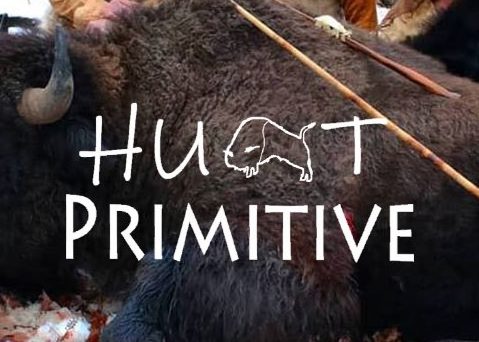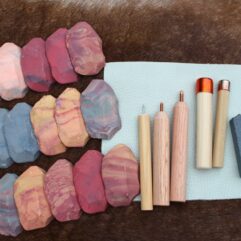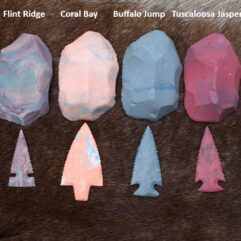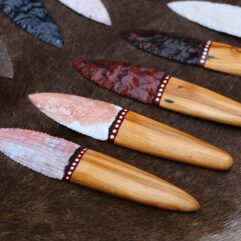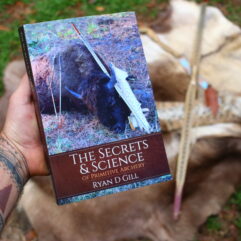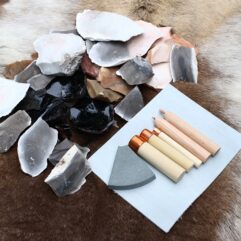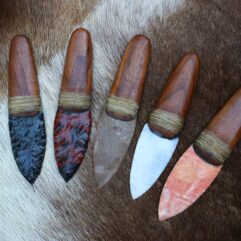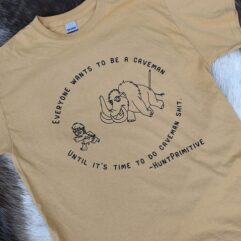Bridging the Gap between Traditional and Primitive Archery
This article is not meant to scare you off from Primitive archery, but it is to make you aware of what you can expect when getting into this more challenging end of archery. Many people experience few problems and shoot happily ever after. Others tend to over analyze and over think the process. Hopefully the following words will set your mind at ease.
I get a numerous amount of questions from archers looking to enter into primitive archery. The questions usually start off with “I have been shooting traditional for X amount of years and I want to get into primitive. What bow should I go with?”
This is not always an easy answer but one thing I always stress is that I believe in all my bows. The preference is really up to the person shooting. If you just want to dip your toe into the primitive water with a wood bow, then my Osage Hunter model is likely your best bet. If you want to jump completely into primitive with as little ties as possible to traditional, then you may want a simpler Cherokee or very basic Aboriginal Model. Mostly it comes down to handle shape. The best thing you can do is look over the models and their handles and choose what you like the most. I do not produce a bad bow. My only real suggestion is to not jump into a flat handled bow if you are not comfortable with that style of grip. If you do get that type of grip, learn to shoot it and don’t give up on it right away at the first sign of “This isn’t as easy as I was expecting.”
Things to remember and make note of. Wood bows are not always the easiest. Most people make a transition to primitive archery because they are looking for more challenge. With a lot of my newer models such as the Osage hunter, Speedgoat, etc the challenge curve is not quite as steep. These bows are more modern interpretations of primitive bows and are typically the most modern-shooter friendly. If you are looking for easy transition, buy a more modern looking model.
I recommend leaving hair splitting specifics at the door. I do this for a living, kill deer every year, and win/place at tournaments with my bows. These bows and arrows shoot with more consistency than the archer’s ability, but often what happens is when an archer makes one bad shot, or shoots a bad group, they start to dissect the gear and find things to play the blame game on. If you bust out the calipers and scale, you will fine a plethora of variations in thicknesses and weights to start assigning blame to. Natural material bows and arrows, in order to work correctly, are supposed to have some small variances. More to follow below. You have to trust that I am truly sending you equipment built on years of experience and not be quick to blame the gear.
I can guarantee you 100% that if you are a knit-picker, you will not be happy in primitive archery. Modern engineering and primitive archery do no get along well. You MUST be willing to accept this prior to taking on this venture. I have been doing this for quite sometime. I am fully confident in what I produce will be of top tier quality regardless of what a tape measure reads. Wood bows change slightly in climate and seasonal change. This is not a big deal at all, but if you are the type of person that gets upset if your bow is listed at 52# and you weighed it at 54#, then primitive archery is likely not for you. Primitive archery requires a certain amount of improvisation as well as a relaxed understanding that things are in a constant state of change. That doesn’t mean that you have 50# bow that will someday for no reason be 60#, but what it does mean is that if you can’t handle a couple pound weight swing, arrows not being the same exact weight, spine, and diameter, then you’ll never be happy in shooting primitive. There are far more variables especially in arrows than you can imagine. Not all cane shafts are the same diameter per the spine rate. Arrows are naturally tapered and it takes a lot of experience to properly spine a cane arrow. You will find my arrows are really darn close and will shoot way better than the archer’s ability, but if you want to break out the grains scale and micrometer to dissect and over analyze your bow and arrow set then you will find that this is far more complicated than other versions of cookie cutter archery.
“My arrows are hitting left no matter what spine I use.” This is a common issue with archers used to shooting modern bows cut to/or passed center with tiny little carbon arrows. When you shoot a primitive bow and a primitive arrow, the bows are not always able to be cut to center. I do try to intentionally align the string on the arrow side to make them as close to center shot as possible. This makes the bow more forgiving as well as more arrow tolerant. Because wood bows are not meant to have a giant cut in sight window, some people experience arrows that hit slightly left. You need to mentally overcome this hurdle. This is a fact of primitive archery. If you shoot enough and train your body to compensate for the left hit, then you will eventually be right on target without noticeably trying to hold right. Again, if this was easy, everyone would do it. Primitive archery requires perseverance, improvisation, and a willingness to adapt. Every bow is slightly different in this regard.
If something isn’t quite working right with your set and you cannot figure it out from the paragraphs above, then give me a call and we will track down the issue, but 9/10 times the equipment is fine and most people shoot these bows and arrows problem free, but strange occurrences do occasionally happen.
